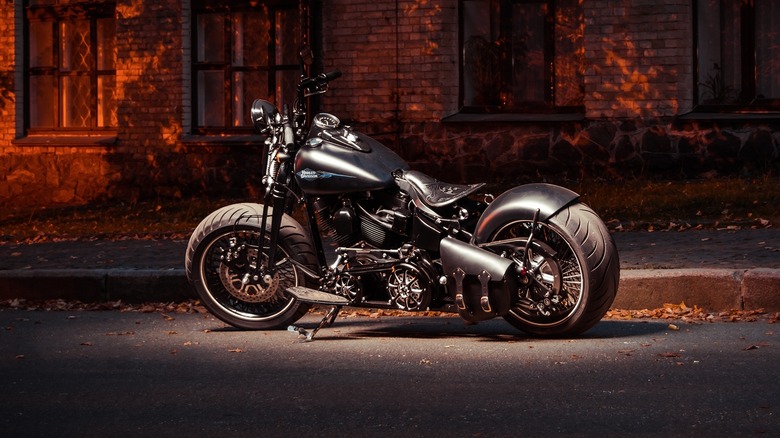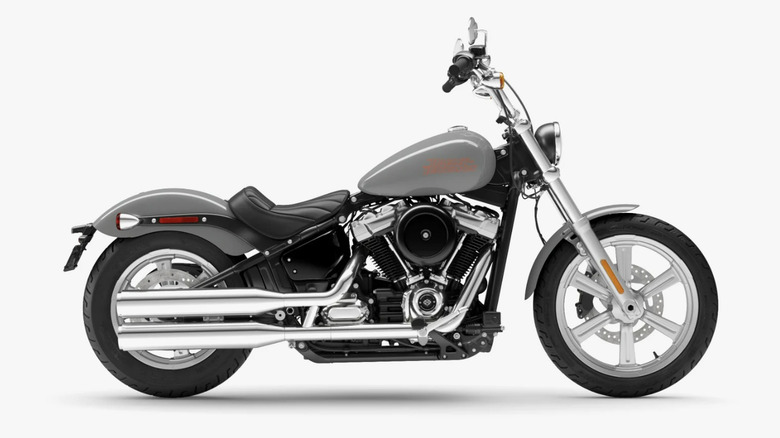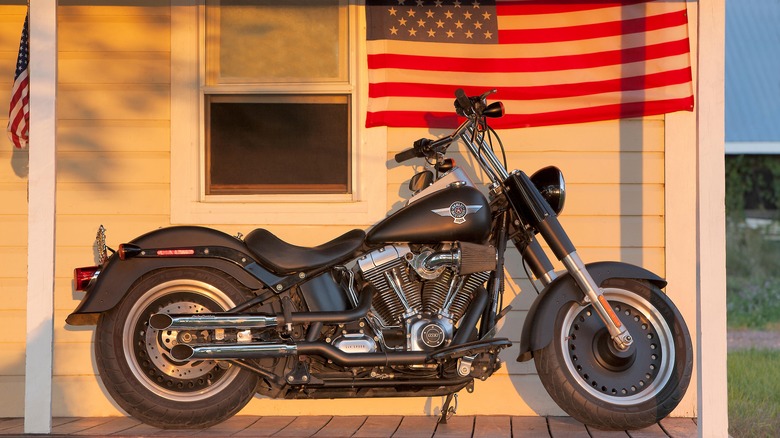Harley-Davidson Softail Standard Vs. Fat Boy: What's The Difference Between These Bikes?
Although Harley-Davidson is more than a century old, with crucial moments that shaped what the company is today, it wasn't until 1983 that it would put out its first Softail model, the FXST Softail. The company had only started manufacturing the model a year earlier, building on mechanical engineer Bill Davis' designs. Davis had dreamt of a motorcycle that embodied the charm and power of the popular Hardtail, but with riding comfort that could only be achieved by installing a rear suspension to the bike. He tinkered with his 1972 FX Super Glide, using it as a prototype, and soon turned his dream into a reality. Davis approached Harley-Davidson with his design, hoping the company could implement it in its models, and soon afterward, the Softail was born.
The FXST Softail, also known as the Softail Standard, was a massive hit. Many motorcycle lovers instantly connected with this original version thanks to its comfortable riding experience, the smooth-running yet powerful Milwaukee-Eight 107 engines, which produced 87 horsepower and 111 lb-ft of torque, and its ability to be customized. There was also the iconic hidden rear suspension, which differentiated it from the rest of Harley-Davidson's motorcycles.
It only took Harley-Davidson six years to drop the next cruiser in its growing Softail family: the Fat Boy, which would embody America's very brawn. The bike took two years to develop, with Willie G. Davidson and Louie Netz spearheading its design. While the original Fat Boy came equipped with all the bells and whistles of the Softail Standard, like the frame, engine internals, and dash, it also had several unique features that would set it apart from its siblings, like two seats instead of the Standard's one.
The 2024 Fat Boy 114 vs. the 2024 Softail Standard
The Fat Boy, especially the 2024 Fat Boy 114, sets itself apart from the 2024 Softail Standard in several ways. To start, the Fat Boy's riding position is relaxed, while the Standard's is upright. The foot controls are on the floorboards on the Fat Boy instead of mid-mount as on the Standard. Additionally, the Fat Boy has the option for four colors and comes with a passenger seat, while the Standard only has two colors.
Length-wise, the Fat Boy is a little longer at 2,370 millimeters compared to the Standard's 2,320, and its width is 985 millimeters against the Standard's 865 millimeters. It also beats the Standard's wheelbase of 1,630 millimeters with its 1,665 millimeters. However, the standard has a higher ground clearance of 125 millimeters, 10 millimeters more than the Fat Boy's 115 millimeters, and a higher seat height of 680 millimeters than the Fat Boy's 675 millimeters.
The tire types also differ on the two bikes, with the Fat Boy sporting Michelin Scorcher 11 tires both front and rear, while its big brother comes with the Dunlop Harley-Davidson Series Blackwall wheels. The tire specification also differs, with the Fat Boy's wheels being thicker than the Standard's.
These are some of America's greatest treasures
The two bikes have some of the most reliable engines Harley-Davidson has ever built: the Milwaukee-Eight 114 for the Fat Boy 114 and the Milwaukee-Eight 107 for the Softail Standard. However, the bikes' displacement differs, at 1,868cc for the Fat Boy and 1,745cc for the Standard. While the electronic sequential port fuel injection fuel system is the same, the two bikes come with different exhausts: 2-into-2 staggered with a catalyst in muffler for the Fat Boy and 2-into-2 shotgun with a catalyst in muffler for the Standard.
The Fat Boy has more power than the Softail Standard, with 94 hp at 5,020 rpm and an engine torque of 155 Nm. The Standard clocks in at 86 hp at 5,020 rpm and has an engine torque of 144 Nm. The ready-to-ride weight of the Fat Boy is 699 pounds, 44 pounds heavier than the Standard's 655 pounds. Its wheels are also different. The Fat Boy has machined Lakester cast aluminum wheels both front and rear, while the Standard has silver Annihilator cast aluminum wheels.
The brakes also differ, with the Standard's solid, uniform expansion rotors compared to the Fat Boy's front and rear silver split seven-spoke floating rotors. The Fat Boy also comes with different front forks and rear shocks, lights, and gauges. But despite all these differences, the Fat Boy and Softail Standard are still some of the best Harley-Davidson motorcycles ever to grace the roads. Their ground-breaking rear suspension, iconic Milwaukee-Eight engines, and breathtaking two-part frames make them some of America's greatest treasures.


